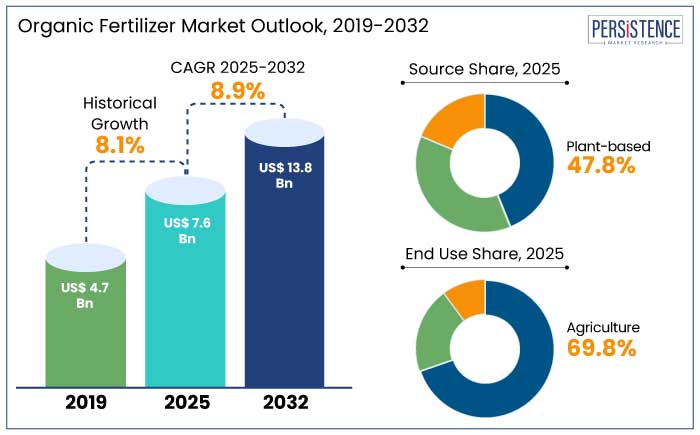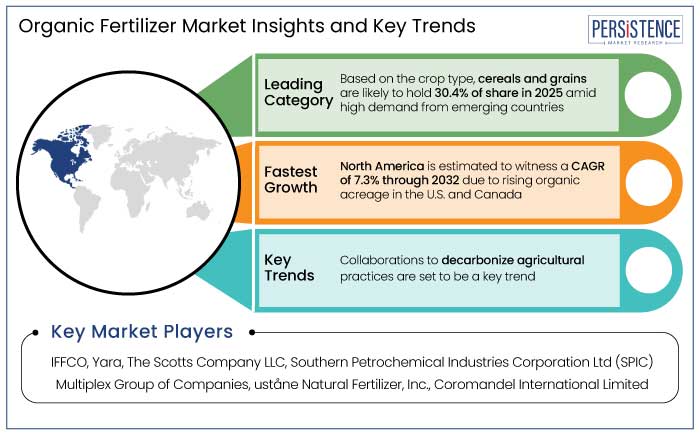Industry: Chemicals and Materials
Published Date: January-2025
Format: PPT*, PDF, EXCEL
Delivery Timelines: Contact Sales
Number of Pages: 190
Report ID: PMRREP11950
The global organic fertilizer market size is projected to rise from US$ 7.6 Bn in 2025 to US$ 13.8 Bn by 2032. It is anticipated to exhibit a considerable CAGR of 8.9% during the forecast period from 2025 to 2032.
Growth is fueled by the continuous expansion of organic farming, which spans 72.3 million hectares in 187 countries. As organic farming practices gain momentum in countries like Australia, Argentina, and Spain, demand for sustainable agricultural solutions, such as organic fertilizers, is increasing to support improved soil health and high crop yields. Organic food and beverage sales exceeded 106 Bn Euros in 2019, highlighting the robust market potential.
The global agricultural landscape is seeing more areas dedicated to organic activities, including livestock, beekeeping, and aquaculture, which further augment the need for eco-friendly farming inputs. In India, organic farming occupies 2.30 million hectares, representing 2% of the total agricultural land.
Madhya Pradesh leads with 0.76 million hectares under organic cultivation, accounting for 27% of the country’s total organic farming area. Growth in organic farming across key states like Madhya Pradesh, Rajasthan, and Maharashtra is driving significant demand for organic alternatives, creating a robust market opportunity for sustainable agricultural practices. The top 10 states in India, which make up about 80% of the total organic cultivation, highlight the booming market for organic inputs.

Key Highlights of the Market
|
Market Attributes |
Key Insights |
|
Organic Fertilizer Market Size (2025E) |
US$ 7.6 Bn |
|
Projected Market Value (2032F) |
US$ 13.8 Bn |
|
Global Market Growth Rate (CAGR 2025 to 2032) |
8.9% |
|
Historical Market Growth Rate (CAGR 2019 to 2023) |
8.1% |
Europe is set to account for 27.8% of the global organic fertilizer market share in 2025, with significant contributions from countries like Germany. For example,
Europe also benefits from strong policy support and consumer demand for sustainable agricultural solutions. The EU's Farm to Fork Strategy and the Organic Action Plan 2021 to 2027 aim to promote organic farming, with the goal of 25% of EU agricultural land being dedicated to organic farming by 2030. Countries like Germany often face challenges due to compliance with policies like the Common Agricultural Policy (CAP), despite ongoing efforts to increase organic production.
North America is likely to hold around 33.4% share of the global organic fertilizer market in 2025 and witness a CAGR of 7.3% through 2032. This reflects its strong presence in both farming and related sectors.
Organic farmland in the region, particularly in the U.S. and Canada, continues to broaden despite some challenges. The steady increase in organic acreage, with the U.S. and Canada leading the charge, highlights the region's commitment to sustainable farming practices.
North America’s organic farmland grew by 351,488 hectares, marking a 10.7% increase from 2021. Despite a slight decline in organic farmland in the U.S., Canada experienced significant growth, with its organic farmland increasing by 23%, reaching over 1.5 million hectares.
While organic farmland in North America still accounts for only 0.8% of the continent's agricultural land, the market continues to show resilience. The U.S. organic food market surpassed US$ 60 Bn in 2022, with a growth of 4% in sales value.
Organic produce remains the top-selling category, generating US$ 22 Bn, and organic beverages followed by US$ 9 Bn. In Canada, the organic food and beverage market also grew significantly, reaching US$ 7.943 Bn in 2022. As demand for organic products continues to rise, both countries have seen increased exports, with the U.S. extending its organic market globally, despite challenges like Brexit and the war in Ukraine.
Agriculture is projected to hold the highest market share, accounting for 69.8% in 2025. It is driven by the global focus on increasing crop yields sustainably. In 2023, primary crop production reached 9.9 billion tons, surging by 27% since 2010, with cereals like maize, wheat, and rice making up 91% of total production.
Organic farming has also gained traction, with over 96.4 million hectares of organic agricultural land reported globally, marking a 26.6% increase since 2021. Key countries like Australia and India significantly contributed to this growth, with 17.3 million hectares and 2.1 million hectares added, respectively. The surge in organic practices, coupled with high adoption across 188 countries, reflects increasing integration of sustainable farming inputs.
Plant-based organic fertilizers are projected to generate a 47.8% market share in 2025. This is due to their nutrient-rich composition, derived from natural plant materials such as compost, seaweed, and green manure.
Such fertilizers help enhance soil fertility and promote sustainable farming practices, making these highly preferred among organic growers. Increasing awareness of chemical-free agriculture and the benefits of plant-based nutrients has driven their adoption globally, particularly in regions focusing on sustainable crop production and organic farming.
The global organic fertilizer market has witnessed robust growth due to increasing adoption of sustainable agricultural practices and rising demand for chemical-free produce. Growing awareness of environmental degradation and soil health preservation has spurred the adoption of eco-friendly fertilizers. Boom of organic farming practices across developed and developing nations continues to shape market trends, with a focus on plant- and animal-based nutrient sources.

Between 2019 and 2023, the market witnessed a moderate decline, recording a CAGR of 8.1%. This period faced challenges such as fluctuating agricultural input costs, limited awareness of organic practices in certain regions, and a lack of infrastructure for organic farming.
Despite these obstacles, developments in organic farming techniques and increased government support, including subsidies and awareness programs, helped sustain growth momentum. Surging premium pricing models and direct-to-consumer channels also contributed to steady market performance during this time.
The market is poised for robust recovery, with a projected CAGR of 8.9% from 2025 to 2032. High consumer demand for sustainable and natural food products, coupled with developments in organic agricultural inputs and precision farming technologies, is set to drive growth.
Innovations such as plant-based fertilizers, integrated pest management techniques, and enhanced soil health practices will likely support growth. Moreover, emphasis on environmental sustainability and scaling up organic farming initiatives globally positions the market for significant progress in the next ten years.
Launch of Bio-fertilizers like Phosphor-nitro Composts
Introduction of novel bio-fertilizer technologies, including phosphor-nitro composts and liquid bio-fertilizers, is addressing specific soil and crop needs. Backed by research initiatives from organizations like the Indian Council of Agricultural Research (ICAR), these innovations are improving nutrient availability, leading to high crop yields and reduced reliance on chemical inputs.
Government initiatives further bolster the adoption of these technologies. Programs such as PM-PRANAM and Paramparagat Krishi Vikas Yojana (PKVY) offer subsidies and incentives to encourage eco-friendly farming practices.
Significant financial support for biogas projects and incentives for products like Fermented Organic Manure (FOM) are creating a sustainable ecosystem for farmers. This push toward balancing traditional and unique inputs underlines a broad commitment to restoring soil health while supporting environmental sustainability.
Development of Novel Production Facilities
Companies are scaling production facilities to meet rising demand for innovative fertilizers, focusing on reducing environmental impact. For instance,
The establishment of new production lines in strategic markets, such as Tessenderlo Group’s organic pellet facilities in France, demonstrates a focused effort to meet regional demand while adhering to global sustainability goals. These also reflect increasing consumer preference for low-carbon agricultural inputs, aligning with broader climate goals. Continuous innovations in production processes and new product launches underscore the importance of sustainable manufacturing.
Lower Yields Compared to Conventional Farming
Organic farming practices typically yield lower outputs compared to conventional methods. This is primarily due to the absence of synthetic inputs, which are designed to enhance crop productivity and protect against pests and diseases. Organic farmers often face challenges in maintaining nutrient levels and pest control through natural techniques, leading to reduced crop performance.
Organic methods like crop rotation and natural pest deterrents may not be as potent as synthetic fertilizers and pesticides. These limitations make it difficult for organic farming to compete with the high yields achievable through conventional practices.
Collaborations to Decarbonize Agricultural Practices
Partnerships between companies and global initiatives are reshaping agriculture by decarbonizing fertilizer production and improving efficiency. For example,
Companies like Syngenta Group China are advancing microbial fertilizer adoption, leveraging biological solutions to enhance crop yields and soil health. These efforts reflect a broader trend toward eco-friendly farming practices, driven by both corporate sustainability goals and regulatory pressures. With increasing focus on climate-smart agriculture, collaborations and innovations are set to transform traditional farming into a more sustainable, low-impact industry.
Emerging Markets to Fuel Sales through Strategic Acquisitions
The acquisition of regional companies is unlocking significant growth opportunities in emerging markets. For example,
Increased investments in biogas initiatives and microbial fertilizer technologies highlight opportunities for scaling eco-friendly farming practices. With field trials demonstrating improved efficiency and soil health, companies are poised to broaden their reach in underpenetrated regions. This trend is driven by a rising awareness of sustainable practices and government support, making emerging markets an attractive landscape for future growth.
Leading companies such as Fertoz Ltd., BioStar Renewables, and Scotts Miracle-Gro Company control the global organic fertilizer market through strategic acquisitions, research, and innovative manufacturing techniques. For example, to satisfy the increasing demand for environmentally responsible agricultural solutions, Scotts Miracle-Gro has made significant investments in organic fertilizer formulations. Small-scale regional businesses concentrate on affordable products that are adapted to local soil and crop needs, especially in emerging countries like Brazil and India.
Recent Industry Developments
|
Attributes |
Details |
|
Forecast Period |
2025 to 2032 |
|
Historical Data Available for |
2019 to 2023 |
|
Market Analysis |
US$ Billion for Value |
|
Key Regions Covered |
|
|
Key Market Segments Covered |
|
|
Key Companies Profiled in the Report |
|
|
Report Coverage |
|
|
Customization & Pricing |
Available upon request |
By Source
By Crop Type
By Form
By End User
By Region
To know more about delivery timeline for this report Contact Sales

The market is projected to witness a CAGR of 8.9% from 2025 to 2032.
Plant-based sources are set to showcase a CAGR of 8.5% through 2032.
North America is poised to dominate with a share of 33.4% in 2025.
Europe is projected to hold a significant share of 27.8% in 2025.
IFFCO, Yara, The Scotts Company LLC, Southern Petrochemical Industries Corporation Ltd. (SPIC), and Multiplex Group of Companies are the leading manufacturers.